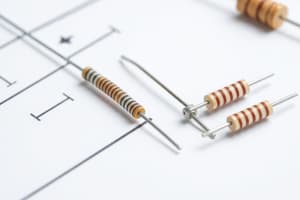Podcast
Questions and Answers
What does the second band represent in a 4-Band Resistor Color Code Chart?
What does the second band represent in a 4-Band Resistor Color Code Chart?
- Second Significant Figure (correct)
- Tolerance
- Temperature Coefficient
- Multiplier
What is the significance of the Grey color in the Multiplier band of a 4-Band Resistor Color Code Chart?
What is the significance of the Grey color in the Multiplier band of a 4-Band Resistor Color Code Chart?
- 100
- 10,000,000
- 100,000
- 100,000,000 (correct)
What does the Brown color represent in the Tolerance band of a 4-Band Resistor Color Code Chart?
What does the Brown color represent in the Tolerance band of a 4-Band Resistor Color Code Chart?
- ±0.05%
- ±1% (correct)
- ±0.5%
- ±10%
What is the significance of the Violet color in the Temperature Coefficient band of a 6-Band Resistor Color Code Chart?
What is the significance of the Violet color in the Temperature Coefficient band of a 6-Band Resistor Color Code Chart?
What is the similarity between the First Significant Figure band in 4-Band, 5-Band, and 6-Band Resistor Color Code Charts?
What is the similarity between the First Significant Figure band in 4-Band, 5-Band, and 6-Band Resistor Color Code Charts?
Flashcards
Second Band in Resistor Color Code
Second Band in Resistor Color Code
Represents the second significant figure in resistor value.
Grey in Multiplier Band
Grey in Multiplier Band
Indicates a multiplier value of 100,000,000.
Brown in Tolerance Band
Brown in Tolerance Band
Denotes a tolerance of ±1%.
Violet in Temperature Coefficient
Violet in Temperature Coefficient
Signup and view all the flashcards
First Significant Figure Similarity
First Significant Figure Similarity
Signup and view all the flashcards
Study Notes
Resistor Color Code Charts
4-Band Resistor Color Code Chart
- Band 1: First Significant Figure
- Black: 0
- Brown: 1
- Red: 2
- Orange: 3
- Yellow: 4
- Green: 5
- Blue: 6
- Violet: 7
- Grey: 8
- White: 9
- Band 2: Second Significant Figure
- Same as Band 1
- Band 3: Multiplier
- Black: 1
- Brown: 10
- Red: 100
- Orange: 1,000
- Yellow: 10,000
- Green: 100,000
- Blue: 1,000,000
- Violet: 10,000,000
- Grey: 100,000,000
- Gold: 0.1
- Silver: 0.01
- Copper: 0.001
- Band 4: Tolerance
- Brown: ±1%
- Red: ±2%
- Green: ±0.5%
- Blue: ±0.25%
- Violet: ±0.1%
- Grey: ±0.05%
- Gold: ±5%
- Silver: ±10%
5-Band Resistor Color Code Chart
- Band 1: First Significant Figure
- Same as 4-Band Resistor
- Band 2: Second Significant Figure
- Same as 4-Band Resistor
- Band 3: Third Significant Figure
- Same as 4-Band Resistor
- Band 4: Multiplier
- Same as 4-Band Resistor
- Band 5: Tolerance
- Same as 4-Band Resistor
6-Band Resistor Color Code Chart
- Band 1: First Significant Figure
- Same as 4-Band Resistor
- Band 2: Second Significant Figure
- Same as 4-Band Resistor
- Band 3: Third Significant Figure
- Same as 4-Band Resistor
- Band 4: Multiplier
- Same as 4-Band Resistor
- Band 5: Tolerance
- Same as 4-Band Resistor
- Band 6: Temperature Coefficient
- Brown: 100 ppm/K
- Red: 50 ppm/K
- Orange: 15 ppm/K
- Yellow: 25 ppm/K
- Green: 20 ppm/K
- Blue: 10 ppm/K
- Violet: 5 ppm/K
Studying That Suits You
Use AI to generate personalized quizzes and flashcards to suit your learning preferences.




